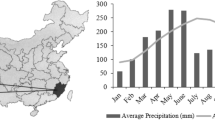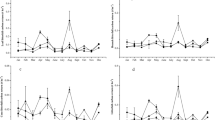Abstract
Biomass production and nutrient (N, P, K, Ca and Mg) accumulation, distribution and cycling were quantified in young, mature and over-mature (10-, 22-, and 34-year old) Chinese fir [Cunninghamia lanceolate (Lamb.) Hook] plantations in southern China. Total stand biomass of young, mature and over-mature stands was 38, 104 and 138 t ha−1 respectively. Biomass production increased significantly with age. Stem wood represented the highest percentage of stand biomass, accounting for 41, 55 and 63 % in the young, mature and over-mature plantations respectively. Nutrients concentration was highest in live needles and branches, and lowest in stem wood. The plantations accumulated more N, followed by K, Ca, Mg, and P. Nutrient return amount, nutrient utilization efficiency, nutrient turnover time, the ratio of nutrient return and uptake increased with stand age, which implies that young Chinese fir deplete soil nutrients to maintain growth, and efficiently utilize nutrients to decrease dependence on soil nutrients as they age. Harvesting young Chinese fir plantations would therefore lead to high nutrient loss, but prolonging the rotation length could improve soil recovery, and help sustain productivity in the long-term. Improved nutrient return through litterfall as stands get older may also be beneficial to nutrient pool recovery.

Similar content being viewed by others
References
Bi J, Blanco JA, Seely B, Kimmins JP, Ding Y, Welham C (2007) Yield decline in Chinese fir plantations: a simulation investigation with implications for model complexity. Can J For Res 37(9):1615–1630
Chang R, Fu B, Liu G, Yao X, Wang S (2012) Effects of soil physicochemical properties and stand age on fine root biomass and vertical distribution of plantation forests in the Loess Plateau of China. Ecol Res 27(4):827–836
Chen HJ (1998) Biomass and nutrient distribution in a Chinese-fir plantation chronosequence in Southwest Hunan. China For Ecol Manag 105(1):209–216
FAO (2007) State of the world’s forests (2007). Food and Agriculture Organization of the United Nations, Rome, pp 88–90
Fernández-Moya J, Murillo R, Portuguez E, Fallas JL, Ríos V, Kottman F, Verjans JM, Mata R, Alvarado A (2015) Nutrient accumulation and export in teak (TectonagrandisL.f.) plantations of Central America. iForest-Biogeosci For 8(1):33–44
Han WX, Fang JY, Guo DL, Zhang Y (2005) Leaf nitrogen and phosphorus stoichiometry across 753 terrestrial plant species in China. New Phytol 168(2):377–385
Hou ZH, Zhang XQ, Xu DY, Yu PT (2009) Study on biomass and productivity of Chinese fir plantation. Chin Agric Sci Bull 25(5):97–103 (In Chinese)
Hu Z, He Z, Huang Z, Fan S, Yu Z, Wang M, Zhuo X, Fang C (2014) Effects of harvest residue management on soil carbon and nitrogen processes in a Chinese fir plantation. For Ecol Manage 326:163–170
Institute of Soil Academia Sinica (1978) Analysis of soil physics and chemistry. Science and Technology of Shanghai Press, Shanghai, pp 274–276 (In Chinese)
Jones JB, Case VW (1990) Sampling, handling, and analyzing plant tissue samples. In: Westerman RL (ed) Soil testing and plant analysis. Soil Science Society of America Inc, Madison, pp 389–427
Kumar JIN, Kumar RN, Bhoi RK, Sajish PR (2009) Quantification of nutrient content in the aboveground biomass of teak plantation in a tropical dry deciduous forest of Udaipur. India J For Sci 55(6):251–256
Li X (1996) Nutrient cycling in a Chinese fir (Cunninghamialanceolata) stand on a poor site in Yishan, Guangxi. For Ecol Manag 89(1):115–123
Lin KM, Ye FM, Lin Y, Li QS (2010) Research advances of phenolic functional mechanisms in soils and plants. Chin J Eco-Agric 18(5):1130–1137 (In Chinese)
Litton CM, Ryan MG, Tinker DB, Knight DH (2003) Belowground and aboveground biomass in young post fire lodge pole pine forests of contrasting tree density. Can J For Res 33(2):351–363
Liu AQ, Fan SH, Lin KM, Ma XQ, Sheng WT (2005) Comparison on nutrient cycling in different generation plantations of Chinese fir. Plant Nutr Fertil Science 11(2):273–278 (In Chinese)
Liu WW, Xiang WH, Tian DL, Yan WD (2010) General allometric equations for estimating Cunninghamialanceolata tree biomass on large scale in southern China. J Cent South Univ For Technol 30(4):7–14 (In Chinese)
Liu XJ, Zhang Y, Han WX, Tang A, Shen JL, Cui ZL, Vitousek P, Erisman JW, Goulding K, Christie P, Fangmeier A, Zhang FS (2013) Enhanced nitrogen deposition over China. Nature 494(7438):459–463
Lodhiyal LS, Singh RP, Singh SP (1995) Structure and function of an age series of poplar plantations in Central Himalaya II. Nutr Dyn Ann Bot 76(2):201
Ma XQ, Liu AQ, Ma Z, Fan SH (2000a) A comparative study on nutrient accumulation and distribution of different generations of Chinese fir plantations. Chin J Appl Ecol 11(4):501–506 (In Chinese)
Ma XQ, Ye SJ, Chen SH (2000b) Effects of rotation on site productivity maintenance of Chinese fir plantation. Sci Silvae Sin 36(6):47–52 (In Chinese)
Ma XQ, Liu CJ, Hannu I, Westman CJ, Liu AQ (2002) Biomass, litterfall and the nutrient fluxes in Chinese fir stands of different age in subtropical China. J For Res 13(3):165–170
Ma XQ, Heal KV, Liu AQ, Jarvis PG (2007) Nutrient cycling and distribution in different-aged plantations of Chinese fir in southern China. For Ecol Manag 243(1):61–74
Pan WT, Tian DL, Li LC, Gao ZH (1981) Study on the nutrient cycling in Chinese fir plantations. J Cent South Univ Technol 1(1):1–21 (In Chinese)
Seo YO, Lee YJ, Lumbres RIC, Pyo JK, Kim RH, Son YM, Lee KH (2013) Influence of stand age class on biomass expansion factor and allometric equations for Pinusrigida plantations in South Korea. Scand J Res 28(6):566–573
SFA (State Forestry Administration of Forest Resources Management) (2010) The 7th national forest resources inventory and the status of forest resources. For Resour Manag 1:1–8 (In Chinese)
Sharma G, Sharma R, Sharma E, Singh KK (2002) Performance of an age series of Alnus-cardamom plantations in the Sikkim Himalaya: nutrient dynamics. Ann Bot 89(3):273–282
Tian DL, Xiang WH, Chen XY, Yan WD, Fang X, Kang WX, Dan XW, Peng CH, Peng YY (2011) A long-term evaluation of biomass production in first and second rotations of Chinese fir plantations at the same site. Forestry 84(4):411–418
Vadeboncoeur MA, Hamburg SP, Yanai RD, Blum JD (2014) Rates of sustainable forest harvest depend on rotation length and weathering of soil minerals. For Ecol Manag 318:194–205
Wang QK, Wang S, Fan B, Yu XJ (2007) Litter production, leaf litter decomposition and nutrient return in Cunninghamialanceolata plantations in South China: effect of planting conifers with broadleaved species. Plant Soil 297(1):201–211
Wang FM, Xu X, Zou B, Guo Z, Li ZA, Zhu WX (2013) Biomass accumulation and carbon sequestration in four different aged Casuarina equisetifolia coastal shelterbelt plantations in south China. PLoS ONE 8(10):e77449
Wood TE, Lawrence D, Clark DA, Chadzon RL (2009) Rain forest nutrient cycling and productivity in response to large-scale litter manipulation. Ecology 90(1):109–121
Xie YR, Zhou ZC (2002) Research advance on adaptation mechanism of forest tree to low-phosphorus stress and genetics of phosphorus efficiency. For Res 15(6):734–740 (In Chinese)
Yang YS, He ZM, Chen GS, Xie JS, Yu XT (2001) PCA of soil fertility under different gaps of continuously planting Chinese fir. Soil Environ Sci 10(1):33–38 (In Chinese)
Yang YS, Guo JF, Chen GS, Xie JS, Cai LP, Lin P (2004) Litterfall, nutrient return, and leaf-decomposition in four plantations compared with a natural forest in subtropical China. Ann For Sci 61(5):465–476
Yang HX, Wang SL, Fan B, Zhang WD, Wei CE (2010) Dynamics of nutrients in an age sequence Pinusmassonianaplantation. Chin J Appl Ecol 21(8):1907–1914 (In Chinese)
Yu XT (1997) Silviculture of Chinese Fir. Fujian Science & Technology Press, Fuzhou, pp 1–7 (In Chinese)
Zhao Q, Zeng DH (2009) Diagnosis method of N and P limitation to tree growth: a review. Chin J Ecol 28:122–128 (In Chinese)
Zhao M, Zhou G-S (2005) Estimation of biomass and net primary productivity of major planted forests in China based on forest inventory data. For Ecol Manag 207(3):295–313
Zhao Q, Liu XY, Zeng DH (2011) Aboveground biomass and nutrient allocation in an age-sequence of Larixolgensis plantations. J For Res 22:71–76
Zhao MF, Xiang WH, Tian DL, Deng XW, Huang ZH, Zhou XL, Peng CH (2013) Effects of increased nitrogen deposition and rotation length on long-term productivity of Cunningham lanceolata in Southern China. PLoS ONE 8(2):e55376. doi:10.1371/journal.pone.0055376
Zhou LL, Addo-Danso SD, Wu PF, Li SB, Ma XQ (2015) Litterfall production and nutrient return in different-aged Chinese (Cunningham lanceolata) plantations in South China. J For Res 26(1):79–89
Zhu F, Yoh M, Gilliam FS, Lu X, Mo J (2013) Nutrient limitation in three lowland tropical forests in southern China receiving nitrogen deposition: insights from fine root responses to nutrient additions. PLoS ONE 8(12):e82661. doi:10.1371/journal.pone.0082661
Acknowledgments
We thank the Xinkou Experimental Forest Farm to support this project. We would also thank Zongkai Jiang, Linlin He and Yayun Jia for assistant with fieldwork. Thanks also to Shanshan Zheng, Xuejiao Chen, Pan Wang and Wenhui Wang for their assistance in the laboratory.
Author information
Authors and Affiliations
Corresponding author
Additional information
Project funding: This work was supported by the Forestry Public Benefit Research Projects of National Forestry Administration under Grant No. 201304303; National Natural Science Foundation of China under Grant No. 31370619; Science and Technology Project of the Fujian Province under Grant No. 2014N0002; and China Postdoctoral Science Foundation under Grant No. 132300148.
The online version is available at http://www.springerlink.com
Corresponding editor: Zhu Hong
Rights and permissions
About this article
Cite this article
Zhou, L., Shalom, AD.D., Wu, P. et al. Biomass production, nutrient cycling and distribution in age-sequence Chinese fir (Cunninghamia lanceolate) plantations in subtropical China. J. For. Res. 27, 357–368 (2016). https://doi.org/10.1007/s11676-015-0167-0
Received:
Accepted:
Published:
Issue Date:
DOI: https://doi.org/10.1007/s11676-015-0167-0




